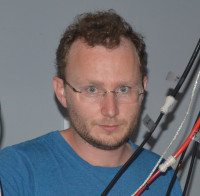Mental Health & Neurology
Post-Doctoral Fellowships
France
2017.09.30
Alzheimer’s disease : pushing the frontier of in vivo neuroimagining
Uncovering the role of dendritic spines in learning and memory impairments
But first, Dr. Stéphane Bancelin’s team needs to establish a new optical paradigm based on super-resolution microscopy. Leveraging on recent advances, they are developing an adaptive approach for super resolved live-cell imaging of a deep brain area based on a state-of-the-art technique called STED (Stimulated Emission Depletion) microscopy. « That’s the most crucial and trickiest part, says the researcher. MRIs, scanners and EEGs are great if you want to look at actions taking place in the brain, but they don’t provide high enough resolution to observe neurons one at a time ». Once the technique is operational, the plan is to perform chronic imaging sessions on mice with and without AD. The morphology and turnover of dendritic spine in the hippocampus will be studied and investigated with the aim of correlating structural changes with memory formation and impairment.
Uncovering the processes that govern information throughout the brain is the cutting edge of modern neuroscience. By pushing the frontiers of neuroimaging, the present project will make a significant contribution towards a better understanding of the mammalian brain, « its uniquely complex and dynamic anatomical organization, (…) like a supercomputer and the Library of Congress rolled into one », as the main investigator puts it. As for his investigation of memory formation in the hippocampus, the output aims to help earlier diagnosis of Alzheimer’s disease and the identification of new therapeutic targets.

Stéphane
BANCELIN
Institution
Université de Bordeaux
Country
France
Nationality
French
Related articles
Mental Health & Neurology
Pandemics & Infectious Diseases
Women's Health
Covid-19
Mental Disorders, Anxiety & Depression
Pregnancy & Maternal Health
Neurodevelopmental Disorders
AXA Award
Spain
2020.08.31
The Effects of the COVID-19 Pandemic on the Mental Health of Mothers and Newborns
Early results are expected in less than 12 months and will help bridge a critical gap in research. Indeed, “in... Read more

Maria
FORASTER
ISGlobal Barcelona Institute for Global Health
Mental Health & Neurology
Pandemics & Infectious Diseases
Mental Disorders, Anxiety & Depression
Covid-19
AXA Award
Spain
2020.08.31
Coping With the Pandemics: What Works Best to Reduce Anxiety & Depression
The results of this longitudinal study will allow Dr. Radua to produce evidence-based, clear, and specific recommendations on effective coping... Read more

Joaquim
RADUA
